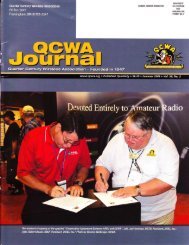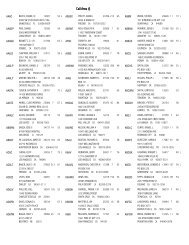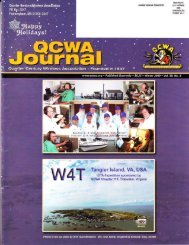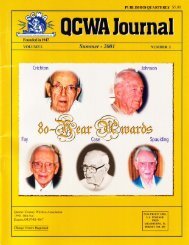Untitled - Quarter Century Wireless Association
Untitled - Quarter Century Wireless Association
Untitled - Quarter Century Wireless Association
Create successful ePaper yourself
Turn your PDF publications into a flip-book with our unique Google optimized e-Paper software.
Olympics in order to train for the job and to iron out any bugs<br />
in the radio installations.<br />
Aside from arnateur radio, there was no other possible<br />
communications for the snow-bound area. These ham radio<br />
operators handled everything from ski accidents to finding out<br />
which snow+at had the trainers' lunches aboard.<br />
Esther spent 14 days at Squaw Valley, which, for her,<br />
was an experience of a lifetime. She was one of three<br />
BAYLARCs who served in this capacity. Altogether, there were<br />
six YLs and about 50 OMs as operators and several other OMs<br />
doing equipment maintenance.<br />
Because she worked within a five mile radius of her<br />
QTH for many years, she was on+all at the local hospital.<br />
Whenever there was a power failure in the rural community, the<br />
hospital's telephone system went out of commission and would<br />
not function under generator operation.<br />
Esther would supply 2-meter communication with the<br />
hospital's headquarters hospital in San Francisco' These<br />
blackouts occurred frequently during heavy storms,<br />
unfortunately, when accident victims were numerous' The<br />
telephone communications problem was solved several years<br />
ago and a ham standby is no longer needed'<br />
She has also been involved in community public<br />
service which includes the following: RACES for 47 years,<br />
guarding emergency frequencies during earthquakes, tidal wave<br />
scares, forest ftres, and heavy storms.<br />
Her QTH is within 500 yards of the Pacific Ocean and<br />
those who live on the coast are very tidal wave conscious' Tidal<br />
Riglrt after World Wff II th€re w€re not many<br />
new Amateur tansmitters on the market; so,<br />
most of us built orr own, eithff tom militaty<br />
surplus radio eqrripment or frun soratch. My<br />
first was frsn scratoh, a 6V6 crystal oscillator<br />
and an 807 final.<br />
Radio tubes we,re easilY obtaind<br />
because the surplus stses had many t)'pes.<br />
Moat mdio equiprnurt us€d during the war had<br />
similar tubes as thry wene established tlpes<br />
then. The 6V6 or 6AG7 tub€s were colnrrron<br />
oscillators, and tlrc 807 was a 75 watt widely<br />
used final; with care you muld drir,rc it to 90<br />
watts input. kr that respec! it was a forertuurer<br />
ofthe 6146 hrbe.<br />
A two stage crystal cortolled rig was<br />
easy to build (still is if you have tlre tr.rbes). We<br />
used plug-in coils to set r.rp the band desired.<br />
The tansmiuer would start out on CW but<br />
later, by building a modulatoto plate, u screen<br />
grid modulate the final it was not difficult to get<br />
on AM ptrone, eith€r. The modulation<br />
tansformer was the keY to success'<br />
Being crystal conholle4 most of us<br />
obtained serreral crystals, keeping in mind some<br />
QCIITA Journal<br />
My Early Stations<br />
By: Pete lturdlmarL N7DUC, 3233 San Pedro Way, Union City, CA 94587'<br />
codd be doubled and oscillate inside the next<br />
bend up. Swihhing crystals was derrel@ to<br />
allow all the crystals to be installed inside the<br />
rig.<br />
The next steP was of mruse a VFO,<br />
which, in my case, drove me nuts for weeks<br />
kying to get my hune brew VFO to stay on<br />
freqr.renry. I eldEd up usug both positive, and<br />
negative coefficie,nt capacitors, tlreofu padding<br />
lhe oscillalor, and a glass bead supported<br />
variable to tune the coil that was wound tightly<br />
on a c€ramic form. Success came at last! It felt<br />
like chains had been removed and I was free!<br />
The little twotube rig made marry<br />
QSOs, sorne of them DX. The bands were not<br />
as crowded then as now and 50 watts worked<br />
fine qr 20 or 40 meters.<br />
Ilallicrafters came out with a twotube<br />
rig, called the IIT-17. I had the<br />
F{allicrafters 5-100 receiver and the HT-17<br />
addition proved to be a perfect match.<br />
I had much fiur with a center fed<br />
dipole, and an end fd 7-W antenna. I used<br />
eithera V-B€am m long wire pointed at Ewope<br />
to enable me to compete with ttle W6<br />
42<br />
waves occur frequently following severe earthquakes and travel<br />
about 500 MPH. Ham radio is an excellent checking system<br />
during one ofthese events.<br />
Her greatest joy in amateur radio has been in lasting<br />
friendships she has accrued in her 48 years of the hobby'<br />
Esther is one of the few women in the Society of<br />
<strong>Wireless</strong> Pioneers, an organization of wireless telegraphers<br />
most of whom were operators aboard ship or at shore stations<br />
carrying marine communications. She was the first woman to<br />
qualiS, for membership in this elite group.<br />
Esther's ham radio activities consist of meeting two<br />
nets each week, one of which is the Ironing Board Net, on 7233<br />
kHz and the other is a round kble of YLs who live along the<br />
coast and meet on 4O-meters, SSB.<br />
Esther uses the Yaezu FT 707 series and she has<br />
capabilities for using 2-meters. She said that she can still copy<br />
CW in her head at around 20 WPM but has not used that mode<br />
of operation for quite some time.<br />
To say the least, Esther has given so much of her time,<br />
talent and tenacity to ham radio, to military service, and to<br />
humanity. She helped pave the way for women who choose to<br />
serve in a military capacity and through her formation of<br />
SWOOP and her ham radio writings, she has provided much<br />
levity for those involved in the hotiby.<br />
Esther, you are tnrly an inspiration to all who know<br />
you. Former Lt. Given, you have given us so very, very much.<br />
Therefore, we regard you very, very highly and former Lt.<br />
Given we salute you for all you have "giveu" to us.<br />
Kilowatters using beams. I heard ore time that<br />
some W6s were running up to 5 kW. It s€em€d<br />
strange ttr,at at tinrcs when hardly any signals<br />
were heard tlrat Califsnians were working DX.<br />
I always put il dov*n as skip omrditions, and<br />
geogmphic adrantages! Hum!<br />
Iater, I b,uilt a ph,unber's &light<br />
beam, a mono-bard three elernent Yagi. I did<br />
mnsider up to fiw elements for otlrer bsnds; but<br />
I fuially settled on a full size three elerrpnt wi&<br />
spaced Yagi fu 20-meters. It was big arrd I<br />
nrean a really BIG antenna.<br />
My advice to new Amatqrs just<br />
starting ort Dqr't be suckered into all<br />
cryrunercial equipffEnq ty building it younelf<br />
It is so satis$ing to use troneb,rew gear and<br />
erperiment with wire antennas.<br />
There are some good DX reaching<br />
models in the trandbooks. I-ook thern up and<br />
buildoneoftlrem.<br />
I hqe to wqk Yor with Your<br />
hornebrew equipment sonredaY!<br />
73 d€ Pete Harrdlnuru N7DUC.



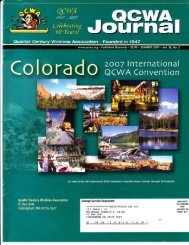
![11{J hI EfifSIt]E I]E - Quarter Century Wireless Association](https://img.yumpu.com/11816560/1/190x245/11j-hi-efifsite-ie-quarter-century-wireless-association.jpg?quality=85)
